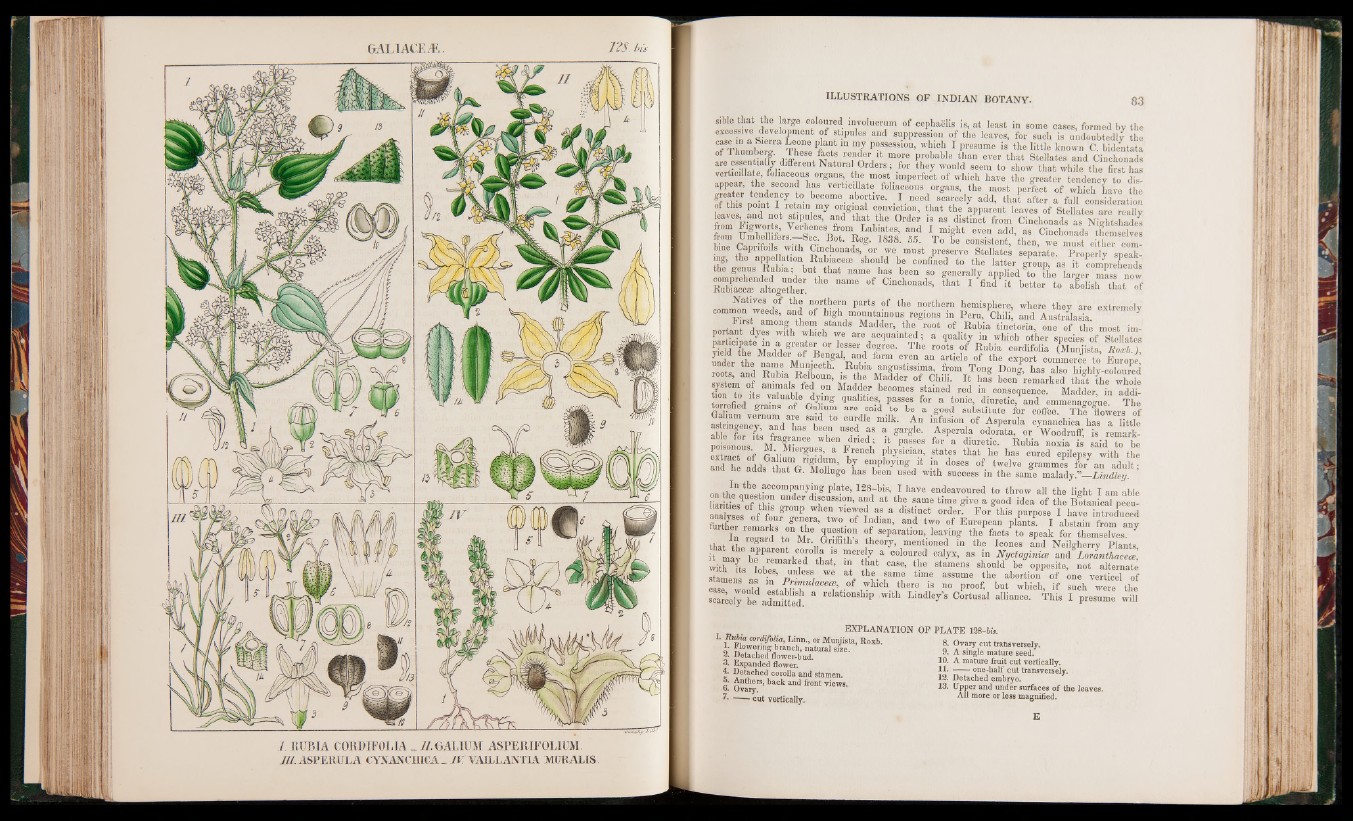
0AL1ACEÆ. 128. lrΣ
ƒ B TIBIA CORDIFOLIA _ JL GALIUM ASPERIFOLIUM
ILL. ASPERULA CYNANCHICA _ IV VAILLANTIA MURALIS.
sible that the large coloured involucrum of cephaelis is, at least in some cases, formed by the
excessive development of stipules and suppression of the leaves, for such is undoubtedly the
™one P.1®”4 m m7 possession, which I presume is the little known C. bidentata
of Thumberg. These fects render it more probable than ever that Stellates and Cinchonads
arV diotA iyi dlfferent Natural Orders; for they would seem to show that while the first has
verticillate, foliaceous organs, the most imperfect of which have the greater tendency to disappear,
the second has verticillate foliaceous organs, the most perfect of which have the
S m r i ^ T L a i t . n?°me- " ' T ™ . I " eed, SCar/ Jely add’ that of this point 1 retain my original conviction, that the apparent leavaefst oo f aS tMellla tecso nasried erreatailolny
leaves and not stipules, and that the Order is as distinct from Cinchonads as Nightshades
from F'gworts, Verbenes from Labiates, and I might even add, as Cinchonads themselves
bme Capntoils with Cinchonaidsf, lo r 18w3e8 ‘ mmust Tpr°e sebrev e— Stellates tsheepna,r awtee. mPursotp eeritlhye ?s pceoamk-!
i i H M M sh°“Id R B | to latter g?oup, as it ^ p r e t n d s
the genus Kubia, but that name has been so generally applied to the larger mass now
E e m t f o g ^ th6 “ame °f CiDCh0nad8’ ^ 1 ^ ^ s h th a tT f
Natives of the northern parts of the northern hemisphere, where they are extremely
common weeds, and 0f high mountainous regions in Peru, Chili; and A u s t r i a . 7
First among them stands Madder, the root of Rubia tinctoria, one of the most im-
partkfipate^in rgreaTe^n 7 are “ f i t t e d ; a quality in which other species of Stellates
vLld t7e l iL d e f Of R l®sser degree. The roots of Rubia cordifolia (Munjista, Roxb.),
yield the Madder of Bengal, and form even an article of the export commerce to Eurora
under the name Munjeeth. Rubia angustissima, from Tong Dong, has also highly-coloured
|syMstemM of aanimi aalissR ffeedd 0Uonn ^MS aHdde r MbneadcdoCmTe s° fs ta^inhei,dL re1d4 bina * cobneesenq^u reenmcaer.k edM* athdadte rt hein° wahdMdie-
torrefie°d L In sUaobfle cda rng T i t l e s passes for a tonic, diuretic,9 and emmenagogue. The
torrehed grains of Galium are said to be a good substitute for coffee. The flowers of
as r e n I y T d ahasSt *° ■ B 7 “ “ °f Asperula c y ^ h i l a h a s T llttfo
able for its HI h b ? U Sj d. T “ gargle> AsPeru!a »dorata, or Woodruff, is remark-
j f f i r f l i r i r f f l i ™ 1 P.a?8es a R S Rubia noxia is’ said to be
ex ract nf ^ a 7 enoh Phy?lclan> states that he has cured epilepsy with the
and he « « 1 ™ ! b7 employing it in doses of twelve grammes fo /a n adult!
ana he adds that G. Mollugo has been used with success in the same maIady.”—Lmdfej,.
„„ fJlIn ^ e accompanying plate, 128-bis, I have endeavoured to throw all the light X am able
lforHies oflhis M M 7 B | at 51 J H H °* m grouP when viem!d as a disStianmcet *oimrdee r&. reF ao rg 0t0hdis idpuearp oosfe t hIe hBaovtea niinctarlo dpueccue-d
■ i i ' M M and two of European M I abstlfn ?rom any
In regaS to Mr B l l 1 seParation, leaving the facts to speak for themselves. 7
that the !nt»d Mr-„Gr.lffith s theory, mentioned in the leones and Neilgherry Plants,
H H B H | “ er![y a coloured calyx, as in Nyctaginia, znALorlnthacev,
With its lohes un?d= that’ case’ tbe stamens shoald be opposite, not alternate
Tamen as P™ , We a* the .same time assume the abortion of one verticel of
1 — B t H Jfhich there is no proof, but which, if such were the
searcely°be^ admitted* ‘ relatl°nsh‘P Wlth Lindley’s Cortusal M l This I presume will
EXPLANATION
I. Riot'd cordifolia, Linn., or Munjista, Roxb.
“ flowering branch, natural size.
Detached flower-bud.
3. Expanded flower.
4. Detached corolla and stamen.
*>• Anthers, back and front views,
o. Ovary.
— - cut vertically.
OF PLATE 128 -bis.
8. Ovary cut transversely.
9. A single mature seed.
10. A mature fruit cut vertically.
11*------ one-half cut transversely.
12. Detached embryo.
13. Upper and under surfaces o f the leaves.
All more or less magnified.
£